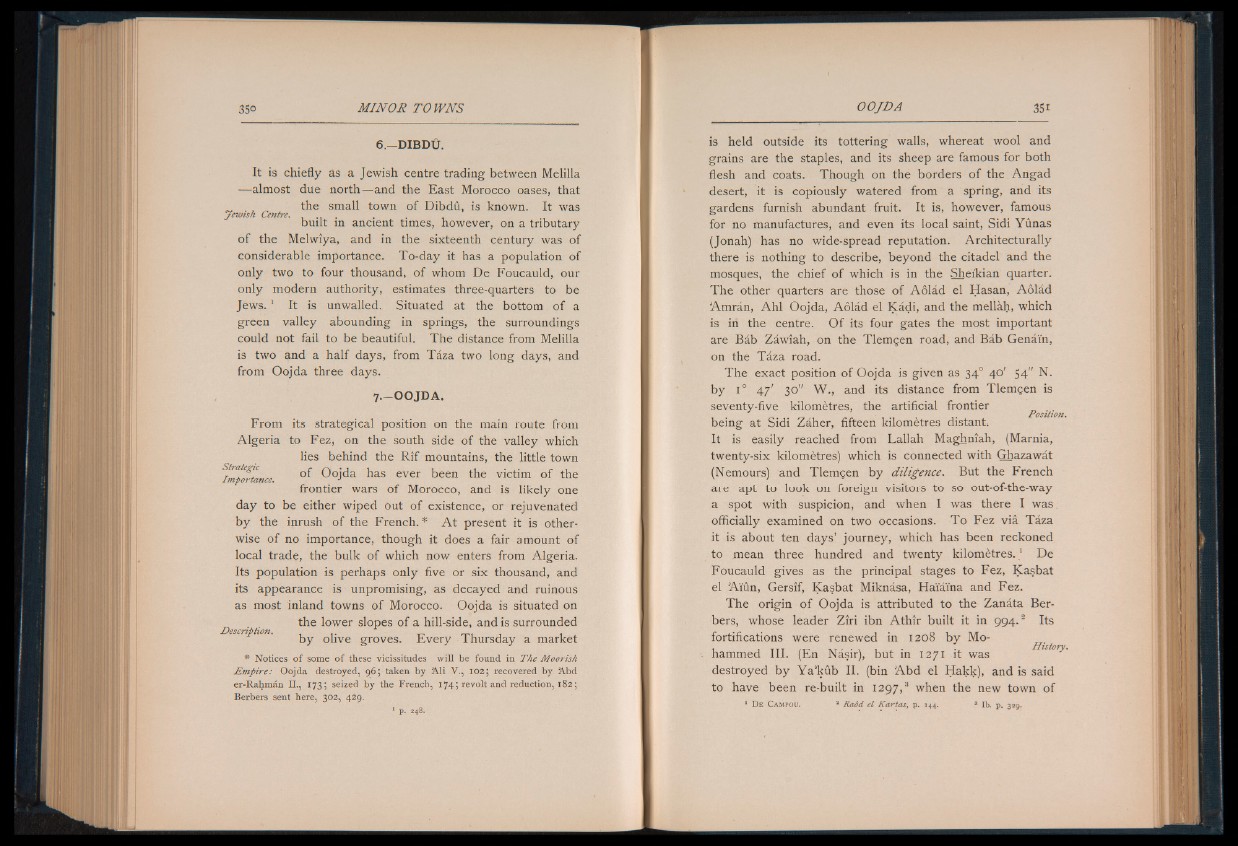
6 — DIBDtJ.
It is chiefly as a Jewish centre trading between Melilla
— almost due north— and the East Morocco oases, that
the small town of Dibdu, is known. It was
Jewtsh Centre, .
built m ancient times, however, on a tributary
of the Melwiya, and in the sixteenth century was of
considerable importance. To-day it has a population of
only two to four thousand, of whom De Foucauld, our
only modern authority, estimates three-quarters to be
Jews.1 It is unwalled. Situated at the bottom of a
green valley abounding in springs, the surroundings
could not fail to be beautiful. The distance from Melilla
is two and a half days, from Taza two long days, and
from Oojda three days.
7.-OOJDA.
From its strategical position on the main route from
Algeria to Fez, on the south side of the valley which
lies behind the Rif mountains, the little town
^Importance Oojda has ever been the victim of the
frontier wars of Morocco, and is likely one
day to be either wiped out of existence, or rejuvenated
by the inrush of the French. * A t present it is otherwise
of no importance, though it does a fair amount of
local trade, the bulk of which now enters from Algeria.
Its population is perhaps only five or six thousand, and
its appearance is unpromising, as decayed and ruinous
as most inland towns of Morocco. Oojda is situated on
the lower slopes of a hill-side, and is surrounded
Description.
by olive groves. Every Thursday a market
* Notices of some of these vicissitudes will be found in The Moorish
Empire: Oojda destroyed, 96; taken by Ali V., 102; recovered by Abd
er-Rahman II., 173; seized by the French, 174; revolt and reduction, 182;
Berbers sent here, 302, 429.
is held outside its tottering walls, whereat wool and
grains are the staples, and its sheep are famous for both
flesh and coats. Though on the borders of the Angad
desert, it is copiously watered from a spring, and its
gardens furnish abundant fruit. It is, however, famous
for no manufactures, and even its local saint, Sidi Yûnas
(Jonah) has no wide-spread reputation. Architecturally
there is nothing to describe, beyond the citadel and the
mosques, the chief of which is in the Sheikian quarter.
The other quarters are those of Aôlâd el Hasan, Aôlâd
Amrân, Ahl Oojda, Aôlâd el Kadi, and the mellàh, which
is in the centre. Of its four gates the most important
are Bâb Zâwîah, on the Tlemçen road, and Bâb Genâïn,
on the Tâza road.
The exact position of Oojda is given as 34° 40' 54" N.
by i° 47' 30" W., and its distance from Tlemçen is
seventy-five kilomètres, the artificial frontier
• r~i / i ^ 1 1 \ t Position. being at Sidi Zaher, fifteen kilometres distant.
It is easily reached from Lallah Maghniah, (Marnia,
twenty-six kilomètres) which is connected with Ghazawât
(Nemours) and Tlemçen by diligence. But the French
are apt to look on foreign visitors to so out-of-the-way
a spot with suspicion, and when I was there I was
officially examined on two occasions. To Fez viâ Tâza
it is about ten days’ journey, which has been reckoned
to mean three hundred and twenty kilomètres.1 De
Foucauld gives as the principal stages to Fez, Kasbat
el Aïûn, Gersif, Kasbat Miknâsa, Haïâïna and Fez.
The origin of Oojda is attributed to the Zanâta Berbers,
whose leader Ziri ibn Athir built it in 994.2 Its
fortifications were renewed in 1208 by Mohammed
III. (En Nâsir), but in 1271 it was
destroyed by Ya'kûb II. (bin A b d el Hakk), and is said
to have been re-built in 1297,3 when the new town of
1 D e C am p o u . 2 Raôd el Kartas, p . 144. 3 lb . p . 329.